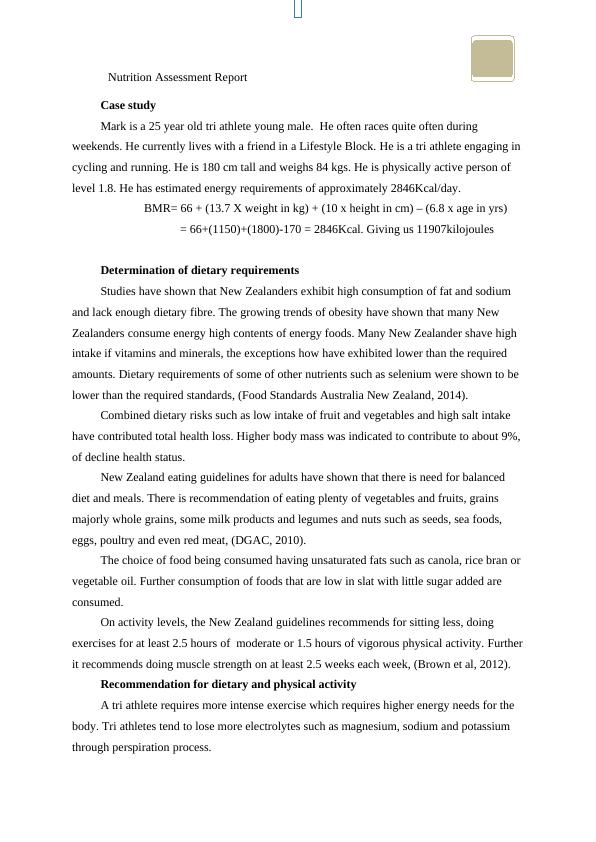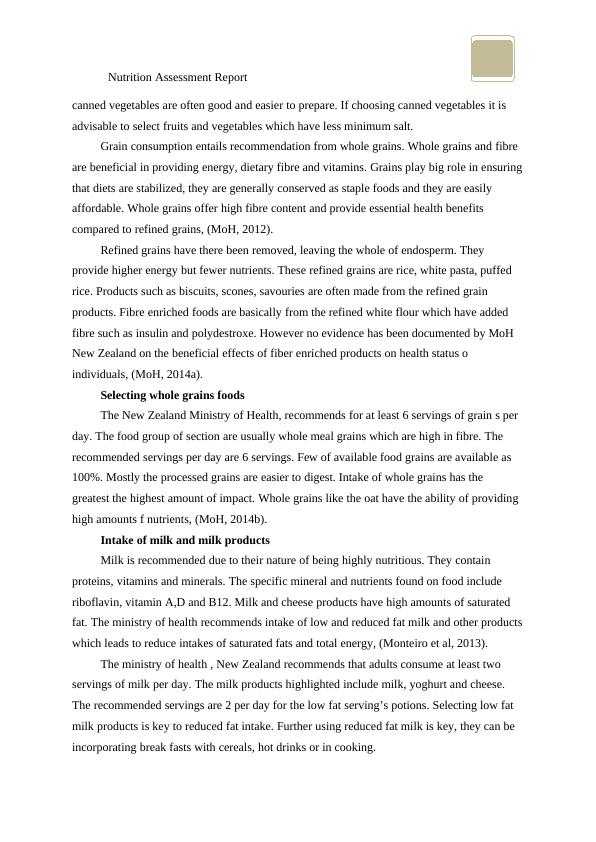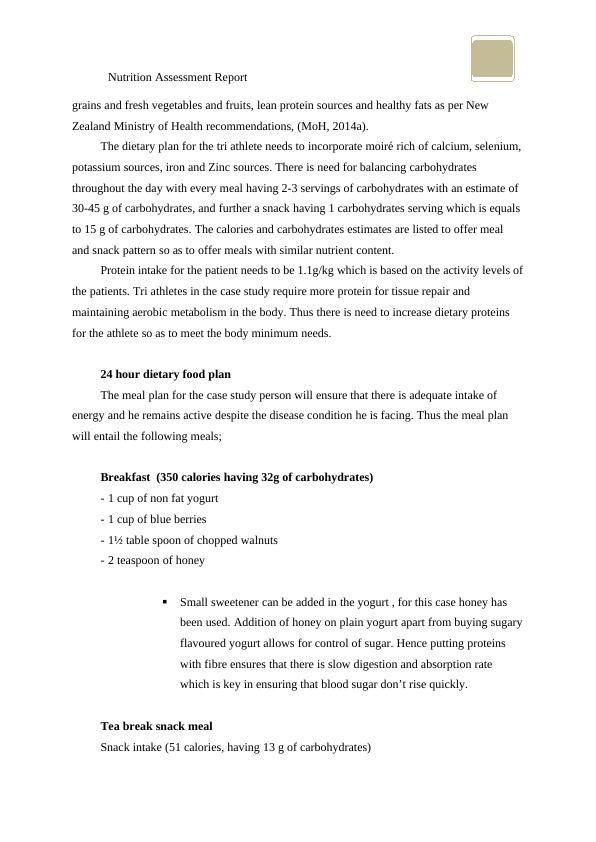Triathlete Mark, 25, is a 25 year old triathlete
Added on 2021-04-20
21 Pages7475 Words103 Views
Nutrition Assessment reportCase study assessmentUniversity Name

Nutrition Assessment Report Case studyMark is a 25 year old tri athlete young male. He often races quite often during weekends. He currently lives with a friend in a Lifestyle Block. He is a tri athlete engaging incycling and running. He is 180 cm tall and weighs 84 kgs. He is physically active person of level 1.8. He has estimated energy requirements of approximately 2846Kcal/day. BMR= 66 + (13.7 X weight in kg) + (10 x height in cm) – (6.8 x age in yrs)= 66+(1150)+(1800)-170 = 2846Kcal. Giving us 11907kilojoulesDetermination of dietary requirementsStudies have shown that New Zealanders exhibit high consumption of fat and sodium and lack enough dietary fibre. The growing trends of obesity have shown that many New Zealanders consume energy high contents of energy foods. Many New Zealander shave high intake if vitamins and minerals, the exceptions how have exhibited lower than the required amounts. Dietary requirements of some of other nutrients such as selenium were shown to be lower than the required standards, (Food Standards Australia New Zealand, 2014). Combined dietary risks such as low intake of fruit and vegetables and high salt intake have contributed total health loss. Higher body mass was indicated to contribute to about 9%,of decline health status. New Zealand eating guidelines for adults have shown that there is need for balanced diet and meals. There is recommendation of eating plenty of vegetables and fruits, grains majorly whole grains, some milk products and legumes and nuts such as seeds, sea foods, eggs, poultry and even red meat, (DGAC, 2010).The choice of food being consumed having unsaturated fats such as canola, rice bran orvegetable oil. Further consumption of foods that are low in slat with little sugar added are consumed.On activity levels, the New Zealand guidelines recommends for sitting less, doing exercises for at least 2.5 hours of moderate or 1.5 hours of vigorous physical activity. Furtherit recommends doing muscle strength on at least 2.5 weeks each week, (Brown et al, 2012). Recommendation for dietary and physical activityA tri athlete requires more intense exercise which requires higher energy needs for the body. Tri athletes tend to lose more electrolytes such as magnesium, sodium and potassium through perspiration process.

Nutrition Assessment Report The New Zealand dietary requirements recommend limiting of processed meats, red meats, drinks and foods with added sugar and highly processed foods. It recognises the need for increased vegetables, legumes, fish, nuts and whole and less processed foods, (Dietary Guidelines Advisory Committee, 2010). Further there is need to exchange various foods such as refined grains, butter, high fat milk products and sugar sweetened beverages. In return it recommends for intake of whole grains and high fibre foods, unsaturated vegetables oils and oil based spreads, low fat milk products, water and low fat milk, (Hooper et al, 2015).On recommendation of physical exercises, the Guidelines allows for increased physical activity, vigorous activity, muscle strengthening exercise activity in exchange of limiting prolong sitting and prolonged screen time.The guidelines give advice on the use of cycling, regular breaks, using stairs, moderate activity, light activity and moderate activity. The guidelines discourage the use of driving for short distances, taking lifts or escalators, light activity, (Lee et al, 2012).Dietary recommendations on eating patterns allows for intake of essential nutrients which lowers the risk of non communicable diseases. Thus the guidelines promoted different kinds of foods for different nutrients. Healthy eating habits involve consumption of food fromall the four food groups. The four food groups have been provided in a framework which contains key nutrients. The food provide clear amount on the food to be eaten, (Mann, 2012).Intake of plenty of vegetables and fruitsVegetables are very good source of vitamins, minerals and fibre and other phyto nutrients. Examples of these foods include the folate greens leafy vegetables, pro vitamin A, green , organic or yellow vegetables. Consumption of vegetables and fruits are key in ensuring prevention of excess weight gain and obesity as these foods have low energy. Further they protect the body from non communicable diseases such stroke, cancers and evenheart related disease. Evidence and studies have shown the importance of non starchy foods and vegetables in the diet.The Ministry of Health recommends consumption of at least three servings of vegetables and 2 servings for fruits per day. Servings’ sizes for vegetables include half a cup cooked vegetables or half cup if salad or mixed vegetables from non starchy group. Starchy vegetables recommend a one medium size potato approximately 135 g, (MoH, 2008).Choosing fresh vegetables and fruits offers great choice for health patterns. Frozen and

Nutrition Assessment Report canned vegetables are often good and easier to prepare. If choosing canned vegetables it is advisable to select fruits and vegetables which have less minimum salt.Grain consumption entails recommendation from whole grains. Whole grains and fibre are beneficial in providing energy, dietary fibre and vitamins. Grains play big role in ensuringthat diets are stabilized, they are generally conserved as staple foods and they are easily affordable. Whole grains offer high fibre content and provide essential health benefits compared to refined grains, (MoH, 2012).Refined grains have there been removed, leaving the whole of endosperm. They provide higher energy but fewer nutrients. These refined grains are rice, white pasta, puffed rice. Products such as biscuits, scones, savouries are often made from the refined grain products. Fibre enriched foods are basically from the refined white flour which have added fibre such as insulin and polydestroxe. However no evidence has been documented by MoH New Zealand on the beneficial effects of fiber enriched products on health status o individuals, (MoH, 2014a). Selecting whole grains foodsThe New Zealand Ministry of Health, recommends for at least 6 servings of grain s per day. The food group of section are usually whole meal grains which are high in fibre. The recommended servings per day are 6 servings. Few of available food grains are available as 100%. Mostly the processed grains are easier to digest. Intake of whole grains has the greatest the highest amount of impact. Whole grains like the oat have the ability of providing high amounts f nutrients, (MoH, 2014b). Intake of milk and milk productsMilk is recommended due to their nature of being highly nutritious. They contain proteins, vitamins and minerals. The specific mineral and nutrients found on food include riboflavin, vitamin A,D and B12. Milk and cheese products have high amounts of saturated fat. The ministry of health recommends intake of low and reduced fat milk and other productswhich leads to reduce intakes of saturated fats and total energy, (Monteiro et al, 2013).The ministry of health , New Zealand recommends that adults consume at least two servings of milk per day. The milk products highlighted include milk, yoghurt and cheese. The recommended servings are 2 per day for the low fat serving’s potions. Selecting low fat milk products is key to reduced fat intake. Further using reduced fat milk is key, they can be incorporating break fasts with cereals, hot drinks or in cooking.

Nutrition Assessment Report Treated milk or evaporated milk, ultra heat treated or the dried milk are the best alternatives for fresh milk. Choosing cheese needs selection of low or moderate fat chesses. Minimise sugar added milk or favoured milk as they have more energy dense content, (Moubarac et al, 2012).Intake and selection of nuts, legumes fish, eggs and red meat with poultryThe eating patterns entails consumption of legumes, nuts, sea foods and fish, as they areliked to lowered levels of cardiovascular disease, reduction in weight gain and prevention of certain types of cancers.Legumes, seeds and nuts are rich in nutrients and are very good sources of proteins. Other types of nuts are useful for specific nutrients like the almonds which provide calcium and Brazil nuts which are rich in selenium. Nuts have high content of unsaturated fat, thus eating small amounts on daily basis is recommended. Intake of oily fish such as salmon, tuna and sardines have good source of omega 3 fatty acids. These nutrients lower the risk of heart disease and stroke occurrence. Consumption of eggs is key as they provide key nutrients which are part of the healthy diet. Poultry serves as a good source of protein and have high nutrient content for minerals such as iron and zinc.Red meat provides an excellent source of key nutrients like iron and zinc. Reduced levels of iron have show t cause problems to many New Zealanders especially young women.Reports from World Cancer research Fund have reported that intake of higher than 500 g of cooked meat every week is liked to increased risk of colorectal cancer, (MoH, 2014a).Consumption of processed meat foods such as salami, bacon and ham are associated with increased risks of colorectal cancer. Further processed meats often have high levels of fat and salt.Selecting legumes, nuts, sea foods and poultry and meatThe Ministry of Health, New Zealand recommends at least intake of two servings of legumes, nuts per day, further at least one serving of fish or any other sea food, eggs, poultry or red meat in a day,( New Zealand Ministry of Health, Mclntyre & Dutton, 2015).Case study state In the case for the individual in the case study, dietary plan is aimed availing nutritious foods which have rich amounts of fibre rich complex carbohydrates. These can include whole

Nutrition Assessment Report grains and fresh vegetables and fruits, lean protein sources and healthy fats as per New Zealand Ministry of Health recommendations, (MoH, 2014a).The dietary plan for the tri athlete needs to incorporate moiré rich of calcium, selenium,potassium sources, iron and Zinc sources. There is need for balancing carbohydrates throughout the day with every meal having 2-3 servings of carbohydrates with an estimate of 30-45 g of carbohydrates, and further a snack having 1 carbohydrates serving which is equals to 15 g of carbohydrates. The calories and carbohydrates estimates are listed to offer meal and snack pattern so as to offer meals with similar nutrient content. Protein intake for the patient needs to be 1.1g/kg which is based on the activity levels ofthe patients. Tri athletes in the case study require more protein for tissue repair and maintaining aerobic metabolism in the body. Thus there is need to increase dietary proteins for the athlete so as to meet the body minimum needs.24 hour dietary food plan The meal plan for the case study person will ensure that there is adequate intake of energy and he remains active despite the disease condition he is facing. Thus the meal plan will entail the following meals;Breakfast (350 calories having 32g of carbohydrates)-1 cup of non fat yogurt-1 cup of blue berries-1½ table spoon of chopped walnuts-2 teaspoon of honeySmall sweetener can be added in the yogurt , for this case honey has been used. Addition of honey on plain yogurt apart from buying sugaryflavoured yogurt allows for control of sugar. Hence putting proteins with fibre ensures that there is slow digestion and absorption rate which is key in ensuring that blood sugar don’t rise quickly.Tea break snack mealSnack intake (51 calories, having 13 g of carbohydrates)

End of preview
Want to access all the pages? Upload your documents or become a member.
Related Documents
Matt's Dietary Intake and Nutritional Analysislg...
|3
|1023
|98
Nutrition And Exercise Plan Managementlg...
|5
|1066
|11
Diet Analysis and Discussion on Human Nutrition and Foodlg...
|5
|2001
|63
Australian Healthy Eating Guidelineslg...
|14
|2218
|84
Mediterranean Diet For Cardiovascular Diseaselg...
|15
|6056
|140
Nutrition Intervention and Planninglg...
|41
|1271
|48
